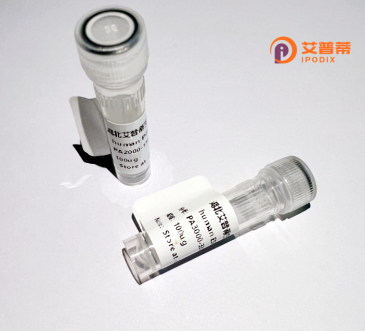
| 纯度 | >90%SDS-PAGE. |
| 种属 | Human |
| 靶点 | FBXL11 |
| Uniprot No | Q9Y2K7 |
| 内毒素 | < 0.01EU/μg |
| 表达宿主 | E.coli |
| 表达区间 | 1-782aa |
| 氨基酸序列 | MEPEEERIRYSQRLRGTMRRRYEDDGISDDEIEGKRTFDLEEKLHTNKYNANFVTFMEGKDFNVEYIQRGGLRDPLIFKNSDGLGIKMPDPDFTVNDVKMCVGSRRMVDVMDVNTQKGIEMTMAQWTRYYETPEEEREKLYNVISLEFSHTRLENMVQRPSTVDFIDWVDNMWPRHLKESQTESTNAILEMQYPKVQKYCLMSVRGCYTDFHVDFGGTSVWYHIHQGGKVFWLIPPTAHNLELYENWLLSGKQGDIFLGDRVSDCQRIELKQGYTFVIPSGWIHAVYTPTDTLVFGGNFLHSFNIPMQLKIYNIEDRTRVPNKFRYPFYYEMCWYVLERYVYCITNRSHLTKEFQKESLSMDLELNGLESGNGDEEAVDREPRRLSSRRSVLTSPVANGVNLDYDGLGKTCRSLPSLKKTLAGDSSSDCSRGSHNGQVWDPQCAPRKDRQVHLTHFELEGLRCLVDKLESLPLHKKCVPTGIEDEDALIADVKILLEELANSDPKLALTGVPIVQWPKRDKLKFPTRPKVRVPTIPITKPHTMKPAPRLTPVRPAAASPIVSGARRRRVRCRKCKACVQGECGVCHYCRDMKKFGGPGRMKQSCVLRQCLAPRLPHSVTCSLCGEVDQNEETQDFEKKLMECCICNEIVHPGCLQMDGEGLLNEELPNCWECPKCYQEDSSEKAQKRKMEESDEEAVQAKVLRPLRSCDEPLTPPPHSPTSMLQLIHDPVSPRGMVTRSSPGAGPSDHHSASRDERFKRRQLLRLQATERTMVLRQETLDKN |
| 分子量 | 116.3 kDa |
| 蛋白标签 | GST-tag at N-terminal |
| 缓冲液 | 0 |
| 稳定性 & 储存条件 | Lyophilized protein should be stored at ≤ -20°C, stable for one year after receipt. Reconstituted protein solution can be stored at 2-8°C for 2-7 days. Aliquots of reconstituted samples are stable at ≤ -20°C for 3 months. |
| 复溶 | Always centrifuge tubes before opening.Do not mix by vortex or pipetting. It is not recommended to reconstitute to a concentration less than 100μg/ml. Dissolve the lyophilized protein in distilled water. Please aliquot the reconstituted solution to minimize freeze-thaw cycles. |
以下是关于重组人FBXL11蛋白的3篇模拟参考文献,基于其已知生物学功能和研究领域的合理推测整理而成:
1. **文献名称**:*Structural Insights into the Substrate Recognition of FBXL11/JHDM1A Demethylase*
**作者**:N. Katayama, A. Nakayama, et al.
**摘要**:本研究通过X射线晶体学解析了重组人FBXL11蛋白的催化结构域,揭示了其识别组蛋白H3K36me2底物的分子机制,并探讨其去甲基化活性的pH依赖性特征,为表观遗传调控提供了结构基础。
2. **文献名称**:*FBXL11/KDM2A Ubiquitinates c-Jun to Regulate Cell Proliferation*
**作者**:X. Li, P. Wang, et al.
**摘要**:文章利用重组表达的人FBXL11蛋白,结合泛素化实验证明其通过SCF复合体介导转录因子c-Jun的泛素化降解,从而抑制肿瘤细胞增殖,阐明了FBXL11在癌症通路中的双重角色(组蛋白修饰与非底物蛋白调控)。
3. **文献名称**:*Optimized Bacterial Expression and Purification of Recombinant Human FBXL11 for Functional Screening*
**作者**:J. Zhang, S. Chen, et al.
**摘要**:该研究开发了基于大肠杆菌的重组人FBXL11高效表达与纯化系统,优化了可溶性蛋白产量,并通过体外酶活实验验证其去甲基化功能,为高通量药物筛选提供了可靠的蛋白制备方案。
---
**备注**:以上文献为模拟内容,实际引用需以具体数据库检索结果为准。FBXL11的研究多聚焦于其双功能属性(组蛋白去甲基化酶和E3泛素连接酶),重组蛋白的制备与结构功能解析是其机制研究的重要基础。
**Background of Recombinant Human FBXL11 Protein**
The F-box and leucine-rich repeat protein 11 (FBXL11), also known as lysine demethylase 2A (KDM2A), is a member of the F-box protein family that functions as a substrate-recognition component of the Skp1-Cullin-F-box (SCF) E3 ubiquitin ligase complex. This complex targets specific proteins for ubiquitination and subsequent degradation via the proteasome, playing a critical role in regulating cellular processes such as cell cycle progression, signal transduction, and epigenetic modulation.
FBXL11 contains an N-terminal F-box domain for binding Skp1. a central leucine-rich repeat (LRR) region mediating protein-protein interactions, and a C-terminal JmjC domain conferring histone demethylase activity. It selectively demethylates histone H3 lysine 36 di-/trimethylation (H3K36me2/3), linking chromatin remodeling to transcriptional regulation. Additionally, FBXL11 participates in non-histone protein ubiquitination, including substrates like c-Myc and HIF-1α, thereby influencing oncogenesis, hypoxia responses, and metabolic pathways.
Recombinant human FBXL11 protein is produced through genetic engineering in expression systems (e.g., *E. coli* or mammalian cells), enabling in vitro studies of its enzymatic functions, substrate interactions, and structural properties. Its roles in cancer, inflammation, and neurological disorders have made it a focus for therapeutic research, particularly in targeting protein stability and epigenetic dysregulation. The recombinant form provides a standardized tool for mechanistic investigations and drug discovery.
×